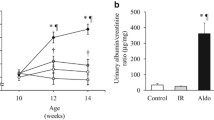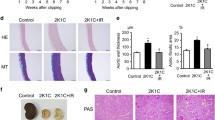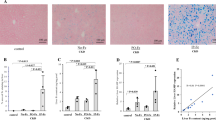Abstract
Purpose
Angiotensin II (ANG II) has been shown to affect iron metabolism through alteration of iron transporters, leading to increased cellular and tissue iron contents. Serum ferritin, a marker of body iron storage, is elevated in various cardiovascular diseases, including hypertension. However, the associated changes in iron absorption and the mechanism underlying increased iron content in a hypertensive state remain unclear.
Methods
The C57BL6/J mice were treated with ANG II to generate a model of hypertension. Mice were divided into three groups: (1) control, (2) ANG II-treated, and (3) ANG II-treated and ANG II receptor blocker (ARB)-administered (ANG II–ARB) groups.
Results
Mice treated with ANG II showed increased serum ferritin levels compared to vehicle-treated control mice. In ANG II-treated mice, duodenal divalent metal transporter-1 and ferroportin (FPN) expression levels were increased and hepatic hepcidin mRNA expression and serum hepcidin concentration were reduced. The mRNA expression of bone morphogenetic protein 6 and CCAAT/enhancer-binding protein alpha, which are regulators of hepcidin, was also down-regulated in the livers of ANG II-treated mice. In terms of tissue iron content, macrophage iron content and renal iron content were increased by ANG II treatment, and these increases were associated with reduced expression of transferrin receptor 1 and FPN and increased expression of ferritin. These changes induced by ANG II treatment were ameliorated by the administration of an ARB.
Conclusions
Angiotensin II (ANG II) altered the expression of duodenal iron transporters and reduced hepcidin levels, contributing to the alteration of body iron distribution.



Similar content being viewed by others
References
Kruszewski M (2003) Labile iron pool: the main determinant of cellular response to oxidative stress. Mutat Res 531(1–2):81–92
Cairo G, Recalcati S, Pietrangelo A, Minotti G (2002) The iron regulatory proteins: targets and modulators of free radical reactions and oxidative damage. Free Radic Biol Med 32(12):1237–1243
Khan ZA, Farhangkhoee H, Barbin YP, Adams PC, Chakrabarti S (2005) Glucose-induced regulation of novel iron transporters in vascular endothelial cell dysfunction. Free Radic Res 39(11):1203–1210. doi:10.1080/10715760500143254
Nanami M, Ookawara T, Otaki Y, Ito K, Moriguchi R, Miyagawa K, Hasuike Y, Izumi M, Eguchi H, Suzuki K, Nakanishi T (2005) Tumor necrosis factor-alpha-induced iron sequestration and oxidative stress in human endothelial cells. Arterioscler Thromb Vasc Biol 25(12):2495–2501. doi:10.1161/01.ATV.0000190610.63878.20
Mehta PK, Griendling KK (2007) Angiotensin II cell signaling: physiological and pathological effects in the cardiovascular system. Am J Physiol Cell Physiol 292(1):C82–C97. doi:10.1152/ajpcell.00287.2006
Ogihara T, Asano T, Ando K, Chiba Y, Sakoda H, Anai M, Shojima N, Ono H, Onishi Y, Fujishiro M, Katagiri H, Fukushima Y, Kikuchi M, Noguchi N, Aburatani H, Komuro I, Fujita T (2002) Angiotensin II-induced insulin resistance is associated with enhanced insulin signaling. Hypertension 40(6):872–879
Henriksen EJ, Jacob S, Kinnick TR, Teachey MK, Krekler M (2001) Selective angiotensin II receptor antagonism reduces insulin resistance in obese Zucker rats. Hypertension 38(4):884–890
Abuissa H, Jones PG, Marso SP, O’Keefe JH Jr (2005) Angiotensin-converting enzyme inhibitors or angiotensin receptor blockers for prevention of type 2 diabetes: a meta-analysis of randomized clinical trials. J Am Coll Cardiol 46(5):821–826. doi:10.1016/j.jacc.2005.05.051
Ishizaka N, Saito K, Noiri E, Sata M, Ikeda H, Ohno A, Ando J, Mori I, Ohno M, Nagai R (2005) Administration of ANG II induces iron deposition and upregulation of TGF-beta1 mRNA in the rat liver. Am J Physiol Regul Integr Comp Physiol 288(4):R1063–R1070. doi:10.1152/ajpregu.00281.2004
Ishizaka N, Aizawa T, Yamazaki I, Usui S, Mori I, Kurokawa K, Tang SS, Ingelfinger JR, Ohno M, Nagai R (2002) Abnormal iron deposition in renal cells in the rat with chronic angiotensin II administration. Lab Invest 82(1):87–96
Ishizaka N, Saito K, Mitani H, Yamazaki I, Sata M, Usui S, Mori I, Ohno M, Nagai R (2002) Iron overload augments angiotensin II-induced cardiac fibrosis and promotes neointima formation. Circulation 106(14):1840–1846
Ishizaka N, Saito K, Mori I, Matsuzaki G, Ohno M, Nagai R (2005) Iron chelation suppresses ferritin upregulation and attenuates vascular dysfunction in the aorta of angiotensin II-infused rats. Arterioscler Thromb Vasc Biol 25(11):2282–2288. doi:10.1161/01.ATV.0000181763.57495.2b
Ishizaka N, Saito K, Furuta K, Matsuzaki G, Koike K, Noiri E, Nagai R (2007) Angiotensin II-induced regulation of the expression and localization of iron metabolism-related genes in the rat kidney. Hypertens Res 30(2):195–202. doi:10.1291/hypres.30.195
Tajima S, Tsuchiya K, Horinouchi Y, Ishizawa K, Ikeda Y, Kihira Y, Shono M, Kawazoe K, Tomita S, Tamaki T (2010) Effect of angiotensin II on iron-transporting protein expression and subsequent intracellular labile iron concentration in human glomerular endothelial cells. Hypertens Res 33(7):713–721. doi:10.1038/hr.2010.63
Piperno A, Trombini P, Gelosa M, Mauri V, Pecci V, Vergani A, Salvioni A, Mariani R, Mancia G (2002) Increased serum ferritin is common in men with essential hypertension. J Hypertens 20(8):1513–1518
Wrede CE, Buettner R, Bollheimer LC, Scholmerich J, Palitzsch KD, Hellerbrand C (2006) Association between serum ferritin and the insulin resistance syndrome in a representative population. Eur J Endocrinol 154(2):333–340. doi:10.1530/eje.1.02083
Ikeda Y, Tajima S, Izawa-Ishizawa Y, Kihira Y, Ishizawa K, Tomita S, Tsuchiya K, Tamaki T (2012) Estrogen regulates hepcidin expression via GPR30-BMP6-dependent signaling in hepatocytes. PLoS One 7(7):e40465. doi:10.1371/journal.pone.0040465
Ikeda Y, Enomoto H, Tajima S, Izawa-Ishizawa Y, Kihira Y, Ishizawa K, Tomita S, Tsuchiya K, Tamaki T (2013) Dietary iron restriction inhibits progression of diabetic nephropathy in db/db mice. Am J Physiol Renal Physiol 304(7):F1028–F1036. doi:10.1152/ajprenal.00473.2012
Tajima S, Ikeda Y, Sawada K, Yamano N, Horinouchi Y, Kihira Y, Ishizawa K, Izawa-Ishizawa Y, Kawazoe K, Tomita S, Minakuchi K, Tsuchiya K, Tamaki T (2012) Iron reduction by deferoxamine leads to amelioration of adiposity via the regulation of oxidative stress and inflammation in obese and type 2 diabetes KKAy mice. Am J Physiol Endocrinol Metab 302(1):E77–E86. doi:10.1152/ajpendo.00033.2011
Mastrogiannaki M, Matak P, Keith B, Simon MC, Vaulont S, Peyssonnaux C (2009) HIF-2alpha, but not HIF-1alpha, promotes iron absorption in mice. J Clin Invest 119(5):1159–1166. doi:10.1172/JCI38499
Nemeth E, Tuttle MS, Powelson J, Vaughn MB, Donovan A, Ward DM, Ganz T, Kaplan J (2004) Hepcidin regulates cellular iron efflux by binding to ferroportin and inducing its internalization. Science 306(5704):2090–2093. doi:10.1126/science.1104742
Andriopoulos B Jr, Corradini E, Xia Y, Faasse SA, Chen S, Grgurevic L, Knutson MD, Pietrangelo A, Vukicevic S, Lin HY, Babitt JL (2009) BMP6 is a key endogenous regulator of hepcidin expression and iron metabolism. Nat Genet 41(4):482–487. doi:10.1038/ng.335
Meynard D, Kautz L, Darnaud V, Canonne-Hergaux F, Coppin H, Roth MP (2009) Lack of the bone morphogenetic protein BMP6 induces massive iron overload. Nat Genet 41(4):478–481. doi:10.1038/ng.320
Courselaud B, Pigeon C, Inoue Y, Inoue J, Gonzalez FJ, Leroyer P, Gilot D, Boudjema K, Guguen-Guillouzo C, Brissot P, Loreal O, Ilyin G (2002) C/EBPalpha regulates hepatic transcription of hepcidin, an antimicrobial peptide and regulator of iron metabolism. Cross-talk between C/EBP pathway and iron metabolism. J Biol Chem 277(43):41163–41170. doi:10.1074/jbc.M202653200
Cohen LA, Gutierrez L, Weiss A, Leichtmann-Bardoogo Y, Zhang DL, Crooks DR, Sougrat R, Morgenstern A, Galy B, Hentze MW, Lazaro FJ, Rouault TA, Meyron-Holtz EG (2010) Serum ferritin is derived primarily from macrophages through a nonclassical secretory pathway. Blood 116(9):1574–1584. doi:10.1182/blood-2009-11-253815
Atlas SA (2007) The renin-angiotensin aldosterone system: pathophysiological role and pharmacologic inhibition. J Manag Care Pharm 13(8 Suppl B):9–20
Catt KJ, Cain MD, Zimmet PZ, Cran E (1969) Blood angiotensin II levels of normal and hypertensive subjects. Br Med J 1(5647):819–821
Jacobs A, Worwood M (1975) Ferritin in serum. Clinical and biochemical implications. N Engl J Med 292(18):951–956. doi:10.1056/NEJM197505012921805
Yeh KY, Yeh M, Watkins JA, Rodriguez-Paris J, Glass J (2000) Dietary iron induces rapid changes in rat intestinal divalent metal transporter expression. Am J Physiol Gastrointest Liver physiol 279(5):G1070–G1079
Donovan A, Lima CA, Pinkus JL, Pinkus GS, Zon LI, Robine S, Andrews NC (2005) The iron exporter ferroportin/Slc40a1 is essential for iron homeostasis. Cell Metab 1(3):191–200. doi:10.1016/j.cmet.2005.01.003
Park CH, Valore EV, Waring AJ, Ganz T (2001) Hepcidin, a urinary antimicrobial peptide synthesized in the liver. J Biol Chem 276(11):7806–7810. doi:10.1074/jbc.M008922200
Brasse-Lagnel C, Karim Z, Letteron P, Bekri S, Bado A, Beaumont C (2011) Intestinal DMT1 cotransporter is down-regulated by hepcidin via proteasome internalization and degradation. Gastroenterology 140(4):1261–1271 e1261. doi:10.1053/j.gastro.2010.12.037
Frazer DM, Wilkins SJ, Becker EM, Vulpe CD, McKie AT, Trinder D, Anderson GJ (2002) Hepcidin expression inversely correlates with the expression of duodenal iron transporters and iron absorption in rats. Gastroenterology 123(3):835–844
Pigeon C, Ilyin G, Courselaud B, Leroyer P, Turlin B, Brissot P, Loreal O (2001) A new mouse liver-specific gene, encoding a protein homologous to human antimicrobial peptide hepcidin, is overexpressed during iron overload. J Biol Chem 276(11):7811–7819. doi:10.1074/jbc.M008923200
Hentze MW, Muckenthaler MU, Andrews NC (2004) Balancing acts: molecular control of mammalian iron metabolism. Cell 117(3):285–297
Xia Y, Babitt JL, Sidis Y, Chung RT, Lin HY (2008) Hemojuvelin regulates hepcidin expression via a selective subset of BMP ligands and receptors independently of neogenin. Blood 111(10):5195–5204. doi:10.1182/blood-2007-09-111567
Gkouvatsos K, Wagner J, Papanikolaou G, Sebastiani G, Pantopoulos K (2011) Conditional disruption of mouse HFE2 gene: maintenance of systemic iron homeostasis requires hepatic but not skeletal muscle hemojuvelin. Hepatology 54(5):1800–1807. doi:10.1002/hep.24547
Zhang AS, Gao J, Koeberl DD, Enns CA (2010) The role of hepatocyte hemojuvelin in the regulation of bone morphogenic protein-6 and hepcidin expression in vivo. J Biol Chem 285(22):16416–16423. doi:10.1074/jbc.M110.109488
Corna G, Campana L, Pignatti E, Castiglioni A, Tagliafico E, Bosurgi L, Campanella A, Brunelli S, Manfredi AA, Apostoli P, Silvestri L, Camaschella C, Rovere-Querini P (2010) Polarization dictates iron handling by inflammatory and alternatively activated macrophages. Haematologica 95(11):1814–1822. doi:10.3324/haematol.2010.023879
Recalcati S, Locati M, Marini A, Santambrogio P, Zaninotto F, De Pizzol M, Zammataro L, Girelli D, Cairo G (2010) Differential regulation of iron homeostasis during human macrophage polarized activation. Eur J Immunol 40(3):824–835. doi:10.1002/eji.200939889
Ma LJ, Corsa BA, Zhou J, Yang H, Li H, Tang YW, Babaev VR, Major AS, Linton MF, Fazio S, Hunley TE, Kon V, Fogo AB (2011) Angiotensin type 1 receptor modulates macrophage polarization and renal injury in obesity. Am J Physiol Renal Physiol 300(5):F1203–F1213. doi:10.1152/ajprenal.00468.2010
Yamamoto S, Yancey PG, Zuo Y, Ma LJ, Kaseda R, Fogo AB, Ichikawa I, Linton MF, Fazio S, Kon V (2011) Macrophage polarization by angiotensin II-type 1 receptor aggravates renal injury-acceleration of atherosclerosis. Arterioscler Thromb Vasc Biol 31(12):2856–2864. doi:10.1161/ATVBAHA.111.237198
Rouault TA (2006) The role of iron regulatory proteins in mammalian iron homeostasis and disease. Nat Chem Biol 2(8):406–414. doi:10.1038/nchembio807
Galy B, Ferring-Appel D, Becker C, Gretz N, Grone HJ, Schumann K, Hentze MW (2013) Iron regulatory proteins control a mucosal block to intestinal iron absorption. Cell Rep 3(3):844–857. doi:10.1016/j.celrep.2013.02.026
Vanoaica L, Darshan D, Richman L, Schumann K, Kuhn LC (2010) Intestinal ferritin H is required for an accurate control of iron absorption. Cell Metab 12(3):273–282. doi:10.1016/j.cmet.2010.08.003
Acknowledgments
This work was supported by a JSPS KAKENHI Grant (No. 25750044 to S.T.) and in part by the Regional Innovation Cluster Program and the Setsuro Fujii Memorial Osaka Foundation for Promotion of Fundamental Medical Research (to T.T.), and by a JSPS KAKENHI Grant (No. 24591203 to Y.I.).
Author information
Authors and Affiliations
Corresponding author
Rights and permissions
About this article
Cite this article
Tajima, S., Ikeda, Y., Enomoto, H. et al. Angiotensin II alters the expression of duodenal iron transporters, hepatic hepcidin, and body iron distribution in mice. Eur J Nutr 54, 709–719 (2015). https://doi.org/10.1007/s00394-014-0749-1
Received:
Accepted:
Published:
Issue Date:
DOI: https://doi.org/10.1007/s00394-014-0749-1




